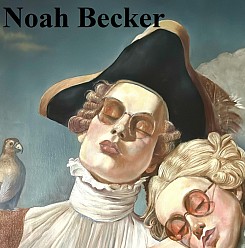Whitehot Magazine
December 2025
"The Best Art In The World"
"The Best Art In The World"
December 2025
Joanna Grochowska’s Future-Forward Figure at The INNOVATE Exhibition
 Joanna Grochowska, Buried, 2021. Courtesy of the artist.
Joanna Grochowska, Buried, 2021. Courtesy of the artist.
The INNOVATE Exhibition
The Untitled Space, New York
September 12 through October 9, 2021
By CORI HUTCHINSON, October 2021
Among artworks featured in The Untitled Space’s INNOVATE, a group exhibition curated by Indira Cesarine focused on novel turns to digital mediums and assorted representations of futurity, is displayed Polish contemporary artist Joanna Grochowska’s Buried: a nude yet organless body, face obscured with soil, and fleshy waist indentations lies horizontally in the frame of a maze-like hardwood. Included among many concepts at play in Grochowska’s work is the relationship between mannequization and mechanization, animate and inanimate, predetermined and determined, life and lifelike. By way of title and pile, Grochowska asks the viewer, “What is buried?” and, concurrently, what posthuman future might be resurrected in its place.
In the catalog essay for Jeffrey Deitch’s future-forward 1992-1993 Post Human group exhibition, Deitch writes, “The redefinition of the figure is being approached by a number of artists through its breakup and reassembly.” Participating artist Charles Ray’s Male Mannequin (1990) represents, according to Deitch, “visions of post-human evolution, drained of all emotion and affect.” Ray’s mannequin figure, unlike Grochowska’s subject, maintains the expression of its head, genitals, and creases between plastic or fiberglass limbs pinned together. The medium of photography and digital image manipulation in Grochowska’s work represents a more affected vision. While both artists work in a similar scale, Joanna Grochowska photographs a further extension of the sculptural concept, fusing rather than collaging mannequin and figure, thereby favoring human enhancement and artificial humanity.
 Joanna Grochowska, Prototype, 2021. Courtesy of the artist.
Joanna Grochowska, Prototype, 2021. Courtesy of the artist.
The mannequin, a life-sized doll form utilized variously as a simulation device, proves a knowing bond between emergent technology and figurative art. Grochowska’s practice embodies the doll of Hans Bellmer’s Doll series, suggesting a redefined balance of power among artist and subject; in Prototype, most overtly, the mirrored subjects are armed with sharp, pelvic blades. One may be reminded also of artist Lee Bul’s Cyborg series featuring armored and headless limbs tactically stanced with obvious and unvarnished supports. Although the body in Buried reclines somewhat inertly, it also flexes its toes, elongating the frame with a slight, internal agency.
 Joanna Grochowska, Opening the Future, 2021. Courtesy of the artist.
Joanna Grochowska, Opening the Future, 2021. Courtesy of the artist.
Gender slippage is suggested in the work of Grochowska with reference to affirmational surgical procedures (Slash Adornment), genetic modification (Angel), and interest in obscuring identity-defining features, such as the face and sexual organs. Often photographed in white, empty space with stark lighting, much of the work alludes to a laboratory environment; in Opening the Future, the subject’s face is veiled by blue surgical masks. Buried deviates as a naturally-lit, more classical setting; the floor pattern indicates a cyborgian path toward the pelvis as if wired. Above the neck, the head is overlaid by a rubble scribble. Across the hips, the stigma imprint in the skin softens the joint connecting torso and legs, while also suggesting the mark of a fetish object. In Buried most prominently, there is a tension between the temporal space the body occupies and the body itself.
 Installation view of The INNOVATE Exhibition. Courtesy of The Untitled Space.
Installation view of The INNOVATE Exhibition. Courtesy of The Untitled Space.
Transgressive and transformational, mannequinization in the work of Joanna Grochowska enacts notions of fluidity and futurity through fragmentation, reassembly, and direct engagement with the viewer. By rudimentary measurement, I counted fourteen bodiless busts and nearly as many headless bodies across the group exhibition, making for a compelling and dynamic assemblage between these two categories. In the glass reflection of Buried, one such abstract work by Shamona Stokes, hung to its left, maps almost directly onto the subject’s neck when standing in a particular position. As Deitch writes, again, “Time is not the only element that is shuffled.” The exhibition on the whole includes variously noteworthy visions, many of which are hung in future-figurative conversation. WM










